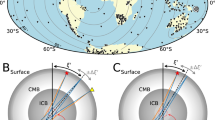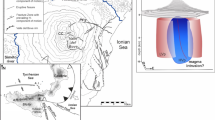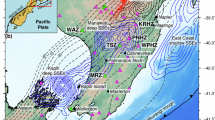Abstract
HITHERTO, wave velocities V in the earth's interior have been calculated from the travel times t of earthquake waves in shallow shocks computed as a function of the epicentral distances Δ. This procedure fails if at any depth the velocity V decreases with depth at a rate in excess of dV/dr = V/r, where r is distance from the centre. In this case a portion of the travel-time curve is formed by the arrival of diffracted waves; if these are misinterpreted as direct waves, incorrect velocities are found not only for the low-velocity layer, but also (with decreasing errors) for all deeper layers. Moreover, discontinuities may be inferred when none actually exists.
This is a preview of subscription content, access via your institution
Access options
Subscribe to this journal
Receive 51 print issues and online access
$199.00 per year
only $3.90 per issue
Buy this article
- Purchase on SpringerLink
- Instant access to full article PDF
Prices may be subject to local taxes which are calculated during checkout
Similar content being viewed by others
References
Mohorovičić, S., Gerlands Beitr. z. Geophys., 13, 225 (1914).
Gutenberg, B., Bull. Seis. Soc. Amer., 38, 121 (1948).
Author information
Authors and Affiliations
Rights and permissions
About this article
Cite this article
GUTENBERG, B. Wave Velocities in the Outer Part of the Earth's Mantle. Nature 170, 289 (1952). https://doi.org/10.1038/170289a0
Issue date:
DOI: https://doi.org/10.1038/170289a0



